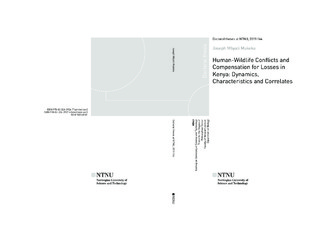| dc.contributor.advisor | Røskaft, Eivin | |
| dc.contributor.advisor | Ogutu, Joseph O. | |
| dc.contributor.advisor | Kanga, Erustus | |
| dc.contributor.author | Mukeka, Joseph Mbyati | |
| dc.date.accessioned | 2019-07-31T11:00:22Z | |
| dc.date.available | 2019-07-31T11:00:22Z | |
| dc.date.issued | 2019 | |
| dc.identifier.isbn | 978-82-326-3927-4 | |
| dc.identifier.issn | 1503-8181 | |
| dc.identifier.uri | http://hdl.handle.net/11250/2606837 | |
| dc.description.abstract | Human-wildlife conflict (HWC) is a common phenomenon around the world and occurs when resource use by humans overlaps with that of wildlife resulting in competition. The major factor exacerbating this situation is human population growth whose secondary effects cascade to land use change, habitat fragmentation, increased livestock numbers, settlements and anthropogenic climate change. Africa, and in particular Kenya, is faced with rapid population growth and highly variable climatic conditions such as extreme floods and prolonged droughts. HWC is common in Kenya because of the high wildlife population and diversity and because most wildlife are found in communal lands outside protected areas (PA). The major conflict types in Kenya are crop raiding, attacks on humans (causing death or injury), livestock depredation, and property damage. HWC negatively impacts the livelihoods of people and therefore people often retaliate by killing the offending wildlife. Thus, HWC threaten biodiversity conservation and may lead to local extinction of some species.
In Kenya, two regions contain most of the wildlife, namely the Mara Region in Narok County which hosts the famous Maasai Mara National Reserve (MMNR) and the Greater Tsavo Ecosystem (GTE) found in south eastern Kenya. The two regions are inhabited by people who have adopted different lifestyles to earn their livelihoods. The Mara region is settled predominantly by the pastoral Maasai community and the GTE is occupied mostly by different communities who practice agriculture. The common fauna in both the Mara and Tsavo consist of large herbivores like the African elephant, African buffalo, and Burchell's zebra. Large carnivores, such as the lion, leopard, and spotted hyena are also found as are nonhuman primates, including baboons and monkeys. We analyzed whether there were differences in the relative frequencies of HWC for 15 years (2001 to 2016) based on data collected by the Kenya Wildlife Service (KWS). The elephant was the leading species causing crop damage, followed by nonhuman primates and buffalo. The lion and spotted hyena were the leading causes of livestock depredation. Interestingly, fewer people felt threatened by wildlife in the Mara than in the Tsavo region, likely because of the historical co-existence and tolerance of wildlife by the Maasai community.
In the Greater Tsavo Ecosystem (GTE) (1995-2017), the elephant and nonhuman primates caused most crop raiding conflicts, but distinct spatial differences were apparent such that the Taveta region was an elephant conflict hotspot while snake conflicts were the highest in Mutomo. Moreover, elephant conflicts were positively and linearly related with human, elephant and livestock densities. Besides there was strong positive average trend because rainfall is the principal climatic component governing variation in food and water availability. For the Mara region, we analyzed HWC and their correlates for the period 2001 - 2017. Three carnivores caused most livestock depredation with the lion killing most of the cattle whereas the leopard and spotted hyena killed the smaller sheep and goats. The elephant was the leading crop raiding species and preferentially fed on maize and wheat while the nonhuman primates were responsible for most tuber crop destruction.
One method of ameliorating these conflicts is compensation for losses. We analyzed compensation payments by the government of Kenya in 2007 - 2016. Snakes were the leading cause of human deaths and injuries in dry regions of Kenya. HWC increased with increase in the percentage area under protection in each county. HWC also varied with population demography such that more males than females and more adults than children suffered from HWC incidents.
The level of resource allocated for preventing or mitigating HWC should portray regional and spatial distinctions. Seasonality in HWC can be addressed by adopting crops that mature at different times and are less palatable where the risk of crop raiding is high. High livestock depredation can be minimized through better husbandry practices. People living with wildlife also need to benefit more from conservation. The national compensation scheme for HWC losses requires adequate funding to cater for the increasing HWC cases. | nb_NO |
| dc.language.iso | eng | nb_NO |
| dc.publisher | NTNU | nb_NO |
| dc.relation.ispartofseries | Doctoral theses at NTNU;2019:164 | |
| dc.relation.haspart | Paper 1: Mukeka, J., Ogutu, J.O., Kanga, E., & Røskaft, E. (2018). Characteristics of Human- Wildlife Conflicts in Kenya: Examples of Tsavo and Maasai Mara Regions. Environment and Natural Resources Research, 8(3), 148
- This is an open-access article distributed under the terms and conditions of the Creative Commons Attribution
license (http://creativecommons.org/licenses/by/4.0/).
https://doi.org/10.5539/enrr.v8n3p148 | nb_NO |
| dc.relation.haspart | Paper 2: Mukeka, J., Ogutu, J.O., Kanga, E., & Røskaft, E. (2018). Spatial and temporal dynamics of human-wildlife conflicts in the Greater Tsavo Ecosystem, Kenya.
- This is an open access article under the CC BY-NC-ND license. The final published version is available at
https://doi.org/10.1016/j.gecco.2019.e00620 | nb_NO |
| dc.relation.haspart | Paper 3: Mukeka, J., Ogutu, J.O., Kanga, E., & Røskaft, E. (2019). Human-Wildlife Conflicts and their correlates in Narok County, Kenya
- This paper is awaiting publication and is not included in NTNU Open | nb_NO |
| dc.relation.haspart | Paper 4: Mukeka, J., Ogutu, J.O., Kanga, E., & Røskaft, E. (2019). Trends in compensation for human-wildlife conflict losses in Kenya.
- This article is published under the terms of the Creative Commons Attribution License 4.0
The final published version is available at
https://doi.org/10.5897/IJBC2019.1278 | nb_NO |
| dc.title | Human-Wildlife Conflicts and Compensation for Losses in Kenya: Dynamics, Characteristics and Correlates | nb_NO |
| dc.type | Doctoral thesis | nb_NO |
| dc.subject.nsi | VDP::Mathematics and natural science: 400::Basic biosciences: 470 | nb_NO |

